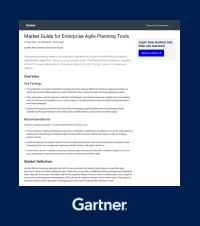7 Resource management best practices for PMOs

What are the most recommended Resource Management best practices? If you are in charge of your organization’s PMO, this post may be of interest to you.
Resource management has become a real headache for organizations. Markets are increasingly competitive, with customers demanding ever more sophisticated products and services tailored to their needs. Against this backdrop, companies are obliged to focus on value and bring new products and services to market faster and faster.
To achieve this, it is necessary to manage resources in an agile and efficient manner, aligned with the organization’s strategic objectives. This is where many PMO leaders and resource managers fail to plan resources across the portfolio or the different work areas of the organization.
Burned out teams and staff, delays in the delivery of key projects for the organization, loss of competitiveness and responsiveness in the market. Do you want to prevent that from happening to you too? In this article, we explain the best practices to follow for efficient management of your organization’s resources and capabilities.
What is Resource Management and Capacity Planning?
But before we go into detail, let’s first introduce the concepts of Resource Management and Capacity Planning in order to understand the importance of this element for the success of companies.
We can define Resource Management as the process by which organizations plan, manage and measure the work of their people and teams. Its main purpose is to plan and allocate these resources efficiently, and thus achieve the maximization of all of them.
Capacity planning, on the other hand, is the process that helps determine whether an organization has the capacity to meet demand over a given period of time.
Resource management and capacity planning are related to each other
These are concepts that, as you can see, are interrelated. Through their efficient management, PMO leaders, Project Managers and Resource Managers will have an overview of all available resources across all teams in the organization, will be able to identify gaps and opportunities for improvement, and plan future resource allocation. In this way, you will be able to:
- Assign staff to projects or initiatives already in progress or still to be planned.
- Classify and organize the organization’s resources according to various parameters: skills, availability, department to which they belong, contractual relationship with the organization, geographic location, etc.
- Track the number of projects underway and the costs and hours of work that each project entails.
Resource management is, therefore, a key issue for organizations at different levels:
- At the Project level, so that project managers have a global vision of the type of resources needed throughout the life cycle of the projects they manage, and the availability of each one of them.
- At the Portfolio level, where PMO managers must analyze the organization’s capacity compared to demand. In addition, efficient resource management at this level will make it possible to optimize resource allocation and capacity planning throughout the entire portfolio, and to make medium- and long-term workload projections.
Why is effective resource management so important?
While most organizations understand the importance of efficient resource management, many fail to effectively plan for it. Why? Surely the first answer that will come to your mind will be one of these: “Because there is a lack of personnel”, “demand management is unmanageable”, or “there are too many projects and not enough qualified people to manage them”.
And it’s true. Resource management has evolved in parallel to the organization’s project portfolio. And while they have become increasingly important to organizations, they are also becoming more complex to manage.
Think about it for a moment. The physiognomy of teams and companies has changed radically in the last 10 years. Due to the irruption of Agile methodologies, within the same company, teams working according to these approaches can coexist with other more classic waterfall models, or even hybrid approaches that take elements from both sides.
Organizations must have efficient tools with which to manage their resources
In addition, an increasing number of multidisciplinary teams and departments are geographically decentralized or working remotely. This has led to the development of new ways of communication and collaboration between teams to move forward with initiatives and projects.
On the other hand, we also have to take into account how competitive today’s markets are, which require companies to bring products and services to the market faster and faster and to satisfy increasingly demanding users. This makes long-term planning a pipe dream for organizations.
Changes in priorities and strategic objectives are the norm. New and more sophisticated projects and products must be managed by the PMO. Therefore, organizations must have efficient tools with which to manage the organization’s resources throughout its project portfolio.
See the Triskell platform in action in a personal demo
In this new context, you have to understand that resource management best practices are not the same as they were 10-15 years ago. Therefore, for efficient management of all the staff working in one way or another throughout the project portfolio you have to do a retrospective exercise and ask yourself the following questions:
- Do you prioritize project delivery over value delivery?
- Do you still plan the organization’s resources and capabilities for the long term?
- Do you still use only Gantt and Timesheets to manage your resources?
If the answer to any of these questions is yes, it will be difficult for your organization’s resource management to achieve the minimum levels of efficiency required in this competitive environment. Why? Read on and we will explain it to you.
Do you prioritize project delivery over value delivery?
If your organization prioritizes delivering all the projects that come into your PMO instead of focusing on those that add value, your resource management process is not designed to work efficiently.
It is essential to align the portfolio with the strategic objectives of the organization. This will give you a clear vision of the type of projects, products and services that really add value. And you will be able to allocate the most qualified resources to those initiatives that are strategic for the business.
By prioritizing resources and projects according to the value they bring to the organization, your PMO may not only prioritize the initiatives in the portfolio towards value delivery but also refuse to initiate projects that won´t bring little value to the business.
Do you still plan the organization’s resources and capabilities for the long term?
The agile environment in which we live, with increasingly competitive markets, where organizations have to deliver value to their customers in the shortest possible time, makes it increasingly difficult to plan for the long term.
Delivery times are getting increasingly shorter. In addition, the availability of resources is increasingly limited. And not just because of the number of projects and deliverables to manage, but also because the mobility of people between organizations and companies have become more agile than ever before. This makes long-term resource management planning increasingly challenging.
Long-term resource management has become increasingly challenging
I’m sure you are familiar with all of the above. You can see that planning a year ahead in this context is almost impossible, so you will have to reduce the horizon of your planning.
Do you still use only Gantt and Timesheets to manage your resources?
Traditional tools for resource management, such as Gantt or Timesheets, are no longer enough for this purpose. In order to have a complete view of your organization’s resources and capabilities, it is necessary to renew the suite of applications with which you normally carry out this task.
In the case of the Gantt chart, since the emergence of Agile methodologies, it is a tool that by itself is no longer efficient for resource management and capacity planning. The reason is that, due to the frequent changes in team structures and business priorities in this new Agile environment, it is necessary to integrate the Gantt chart into the overall resource management process.
It is necessary to integrate the Gantt chart into the overall resource management process
By doing so, you will link resource management to capacity planning. And you will use the Gantt chart not only to get an overview of how your resources are being used in the organization, but also to plan the organization’s capacity in the medium and long term.
Something similar occurs with Timesheets. So that, for example, a PMO can have a complete view of resource management across the project portfolio, it is necessary that all persons fill in, in addition to the number of hours, additional details such as:
- The name of the project they are working on.
- The project task list
- The percentage of tasks that have already been completed,
- Etc.
There is a lot of information to fill in. And in order to get a complete picture of the organization’s resources, all employees must fill it out in detail. since it is also a time-consuming task, not everyone is going to do it.
See the Triskell platform in action in a personal demo
Capacity Planning and Resource Management best practices
You have probably already identified the areas where your organization’s resource management is failing today. You may also think that, given the current context, efficient planning in this area is impossible. But, believe me, it’s not!
We will not deny that resource and capacity management is one of the most complex tasks faced by any organization. But from Triskell Software we want to make this task easier for you.
And, for this reason, we provide you with the 7 resource management best practices that every PMO leader and resource manager should consider to optimize the use of resources in the organization.
- Plan only 3 – 6 months ahead.
- Prioritizes projects and resources based on the strategic objectives.
- Analyze the demand management and the organization’s capabilities.
- Make a competency matrix of all the teams in the organization.
- Anticipate changes.
- Facilitate the resource allocation process.
- Upgrade resource management in your organization with a PPM software.
1. Plan only 3 – 6 months ahead
Planning your organization’s resources and capabilities 3 to 6 months ahead is a reasonable option. Although this will depend on several factors such as:
- The strategic objectives of the organization. If, for example, your company works with OKRs, it is recommended to align resource planning with the review of strategic objectives, which usually occurs every 3 months.
- The methodologies and work approaches used in your organization (Agile vs. more traditional approaches). The more Agile teams you have in your organization, the shorter the planning horizon should be.
- The organization’s agility in recruiting new staff or replacing those who move internally within the company.
This more short-term planning will allow you to be more reactive, on the one hand, to modifications in the configuration of the teams in the organization and, on the other hand, to possible changes in strategy and objectives that may arise.
2. Prioritizes projects and resources based on the strategic objectives
To be successful, organizations must define their strategic objectives. Then, they must design information and knowledge repositories through which all departments and work teams align their projects and initiatives towards the achievement of these objectives.
Aligning the project portfolio with the organization’s objectives is only the first step. You should also periodically review the project portfolio with stakeholders both to adjust the priorities of ongoing portfolios, programs and projects, and to make adjustments to the resources allocated to each of them.
A good method is, on the one hand, to score projects according to their relevance to the achievement of these objectives. And, on the other hand, identify the most valuable resources within the organization (whether individuals or teams) and assign them to the initiatives that will have the greatest value in terms of meeting these objectives.
Identify the most valuable resources and assign them the initiatives that will deliver the most value
In this way, you will be able to leverage the allocation of resources across the organization’s portfolio. It will also allow you to adjust the delivery dates and priority level of projects according to:
- The availability of those resources
- The importance of ongoing initiatives to the success of the organization.
3. Analyze the demand and the organization’s capabilities
It is necessary that at the portfolio level you make an in-depth analysis of the demand that must be managed by the organization as a whole. On the one hand, you must have a good understanding of the type of projects, products and services provided by the organization. And, on the other hand, you have to know which types of demand are the most important in order to achieve the organization’s strategic objectives.
Once all the demand is listed, it is time to compare it with the current capacity of the organization to cope with all that work. This analysis, instead of using it as a pretext to complain about a possible lack of resources, should be approached as an opportunity to maximize the resources available to the organization. It will help you identify weaknesses and opportunities for improvement to optimize the satisfaction of that demand.
Identify weaknesses and opportunities to optimize demand satisfaction
These weaknesses and opportunities for improvement can take several forms:
- Detect specialties and roles that are not well filled in the organization, and which would be necessary to meet the demand.
- Identify duplicate or non-valuable resources.
- List the most valuable resources for delivering value within the organization.
4. Make a competency matrix of all the teams in the organization
As I just mentioned in the previous point, it is also necessary for the organization’s resource management to be aligned towards delivering value. To this end, it is recommended to make a competency matrix of all the resources in the organization. This matrix should contain both the role and the area to which the resource belongs, as well as the skills and competencies of each of them.
This issue, although it may seem insignificant at first glance, it is vitally important that you do it in case it has not already been done in your organization, as it will allow you to:
- Assign to the different projects and initiatives managed in the organization those resources that, due to their skills and experience, would be the best fit.
- Identify the absence of certain types of skills that could help the organization deliver more value through its portfolio.
- Plan in advance for new projects, especially those that may require resources with skills and expertise that are difficult to find in the market.
All this will allow the organization’s resources to be more productive and acquire a greater sense of belonging to the organization by being focused on the functions that motivate them and in which they best fit.
5. Anticipate and plan changes
In today’s environment, an organization’s objectives can vary as much and more as the range of products and services it brings to the market. This forces portfolio managers to continually make adjustments and changes in executing the business strategy.
Whether you are a PMO manager, or you have the role of managing the resources of your organization, you must plan ahead for possible changes in strategy that may occur in the organization. You have to visualize possible scenarios and see how the resources should be allocated in each case.
‘What-if’ analysis and scenario planning is a functionality already included in many PPM tools such as Triskell Software. It allows resource management to be planned in advance according to each scenario analyzed. This will allow you to understand in advance the impact these changes will have on your organization and develop a contingency plan to allocate resources efficiently in case these changes occur.
What-if analysis and scenario planning allows you to manage resources in advance
So, if you don’t already do so, I recommend you generate your own ‘what-if’ analyses and simulations of possible scenarios. This will bring significant benefits to your organization, such as:
- Automatically and predictively design a portfolio of projects and products focused on delivering value while taking into account the resource constraints of your organization.
- Replanning the portfolio when there are changes in availability and resource requirements.
- Create predictions and scenarios considering the variables that really matter in your organization.
6. Facilitate the resource allocation process
It is useless to carry out all of the above practices if the organization does not activate mechanisms that enable efficient resource management in its day-to-day operations. In an environment as dynamic as the one we live in, it is necessary to have agile resource allocation processes focused on delivering value in the shortest possible time.
You have surely experienced or witnessed situations of this type in your company:
- Resources that, due to their skills and experience, are assigned to carry out tasks for a specific project, but are blocked by the person in charge of the area to which they belong.
- Endless selection processes when looking for personnel outside the organization, which can lead to delays in the delivery dates of key projects for the organization.
- Duplicated resources within the organization, or roles with no relevance for value delivery.
Designing a competency matrix and conducting What-If analysis and scenario planning will help to avoid this type of situation from occurring. But it is also necessary to involve the organization’s managers in order to streamline and optimize resource management.
Resource planning should allow direct negotiation between the project managers who require resources for their projects, and the line manager or resource manager, who ultimately controls their resources. Therefore, you must promote an agile leadership style that fosters collaboration and communication between different areas when acquiring, requesting or sharing resources.
See the Triskell platform in action in a personal demo
7. Upgrade resource management in your organization with a PPM software
There are many PPM tools on the market that, in addition to the classic Gantt and Timesheets, include additional functionalities that allow PMO managers and resource managers to have a complete and real-time view of the resources available in the organization.
For efficient resource management, when deciding which solution to choose, you should make sure that it includes all these functionalities:
- Simulation and scenario planning, so that different scenarios can be compared and decisions regarding the different resource management processes of the organization can be made on the basis of qualitatively justified decisions.
- Scorecards, which will help you determine the importance of each initiative in achieving the organization’s strategic objectives. This will facilitate the allocation of resources and capabilities to those projects that really deliver value.
- Configurable workspaces: in your organization, teams that work following agile approaches may be coexisting with others that use more traditional or hybrid work methodologies. Therefore, it is highly recommended that the interface of your solution is flexible and has Kanban or Masterplan views. In this way, each team can configure the workspace of the tool according to their needs.
- Timesheets: resource management and timesheets are indissociable, so make sure that the solution you choose incorporates this functionality. This way, you will have all the information regarding productivity and time spent on the organization’s projects in a single interface.
Put these Resource Management Best Practices to Work with Triskell Software
Triskell Software is the tool with which, from a single interface, you can manage strategic planning and execution. It has the most advanced functionalities for efficient resource management.
Some of these functionalities worth highlighting are the following.
Detailed view of resource workload and demand:
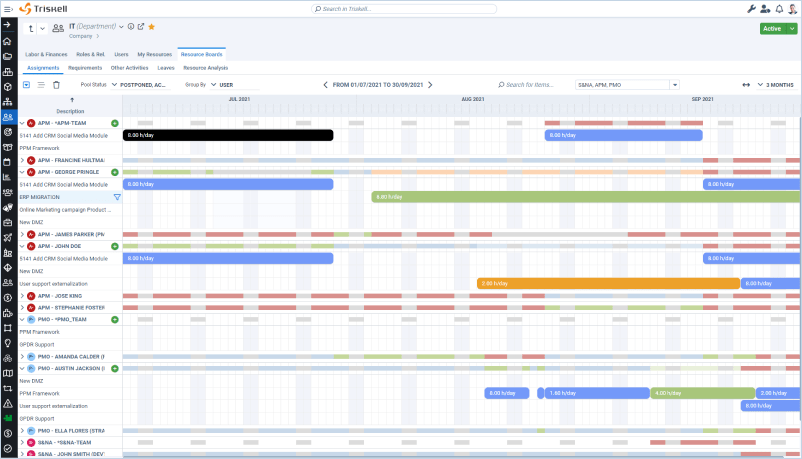
Scenarios and simulations at project, program or portfolio level:
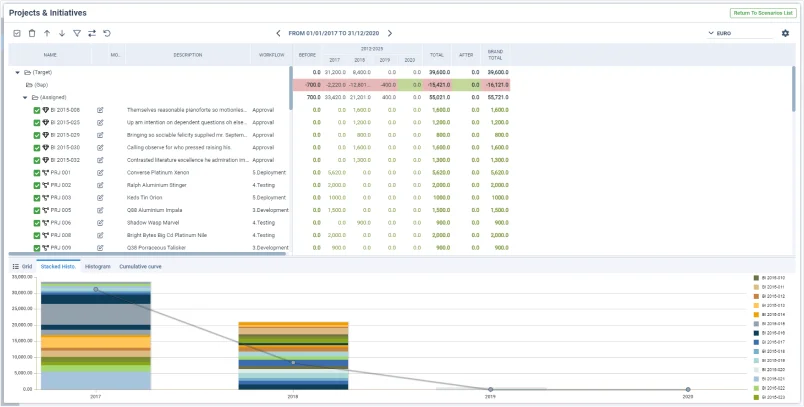
Powerful and easy to use “What-if” features for resource capacity planning:
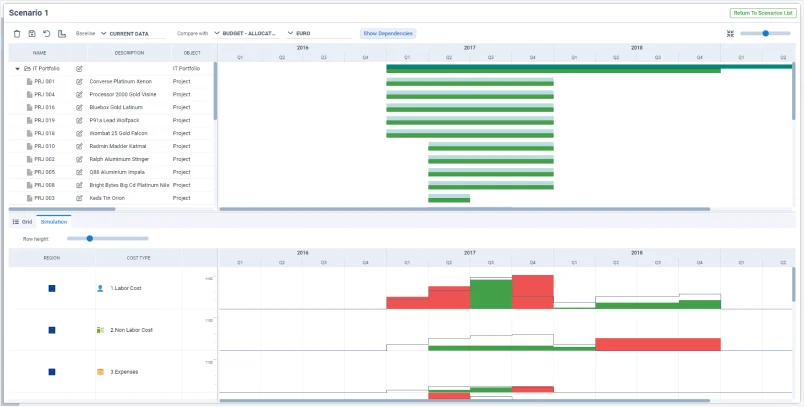
Timesheets for detailed tracking of the organization’s projects and portfolios:
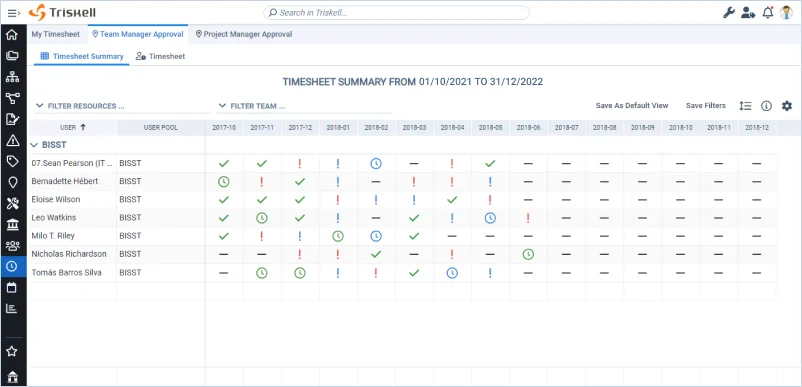
Budget and cost tracking:
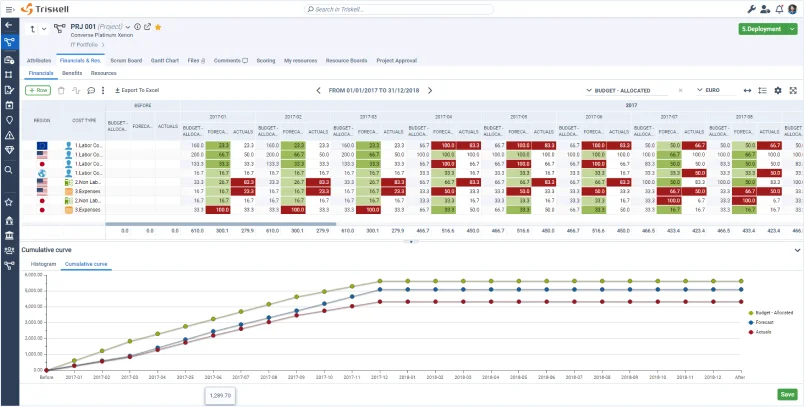
Subscribe to our Newsletter
Get stories like this in your inbox
Request a demo of Triskell Software
Do you think Triskell Software is the solution you need to take your organization’s resource management to excellence? If so, request a demo of Triskell.

FAQs about Resource Management best practices
What are the biggest challenges faced in Resource Management?
While Resource Management offers significant benefits, there can be hurdles to overcome. Some common challenges include:
- Inaccurate forecasting: understanding project demands and resource capacity is crucial. Inaccurate forecasts can lead to overallocation or underallocation of resources.
- Limited visibility: without a clear view of resource availability and workload, making informed decisions about project allocation is difficult.
- Communication silos: information gaps between project managers, resource managers, and teams can lead to inefficiencies and missed deadlines.
How can a PMO improve Resource Management?
PMOs play a vital role in optimizing Resource Management. Here’s how:
- Standardizing processes: Implementing consistent procedures for project intake, prioritization, and resource allocation ensures efficient use of resources.
- Building a competency matrix: A skills matrix helps identify resource skillsets and match them to project requirements.
- Utilizing project portfolio management (PPM) tools: PPM software provides a centralized platform for resource planning, tracking, and reporting.
What are the benefits of using Resource Management best practices?
Following Resource Management best practices can lead to several advantages for your organization:
- Increased project success rates: Effective resource allocation improves project delivery and reduces the risk of failure.
- Enhanced team productivity: By avoiding overallocation and ensuring the right people are assigned to tasks, team productivity is optimized.
- Improved cost control: Resource Management helps identify resource bottlenecks and optimize utilization, leading to cost savings.
How can I get started with implementing Resource Management best practices?
Here are some initial steps you can take to implement Resource Management best practices:
- Assess your current state: Evaluate your existing resource management processes and identify areas for improvement.
- Define your goals: Set clear objectives for what you want to achieve with Resource Management.
- Develop a plan: Outline a roadmap for implementing best practices, including any necessary training or software adoption.
Related Content

Why the CIO needs a PMO approach
Unlock business success: discover why the CIO must embrace a PMO approach! to elevate efficiency and boost productivity.

Lean Budgeting for Agile Portfolios: A Comprehensive Guide
Lean Budgeting: the financial revolution for Agile portfolios. Discover how to streamline project financing and optimize value delivery.

Implementing SAFe with a 7-step roadmap
Do you want to scale Agile at the enterprise level and don’t know where to start? We solve your doubts by explaining the steps to implement SAFe.

